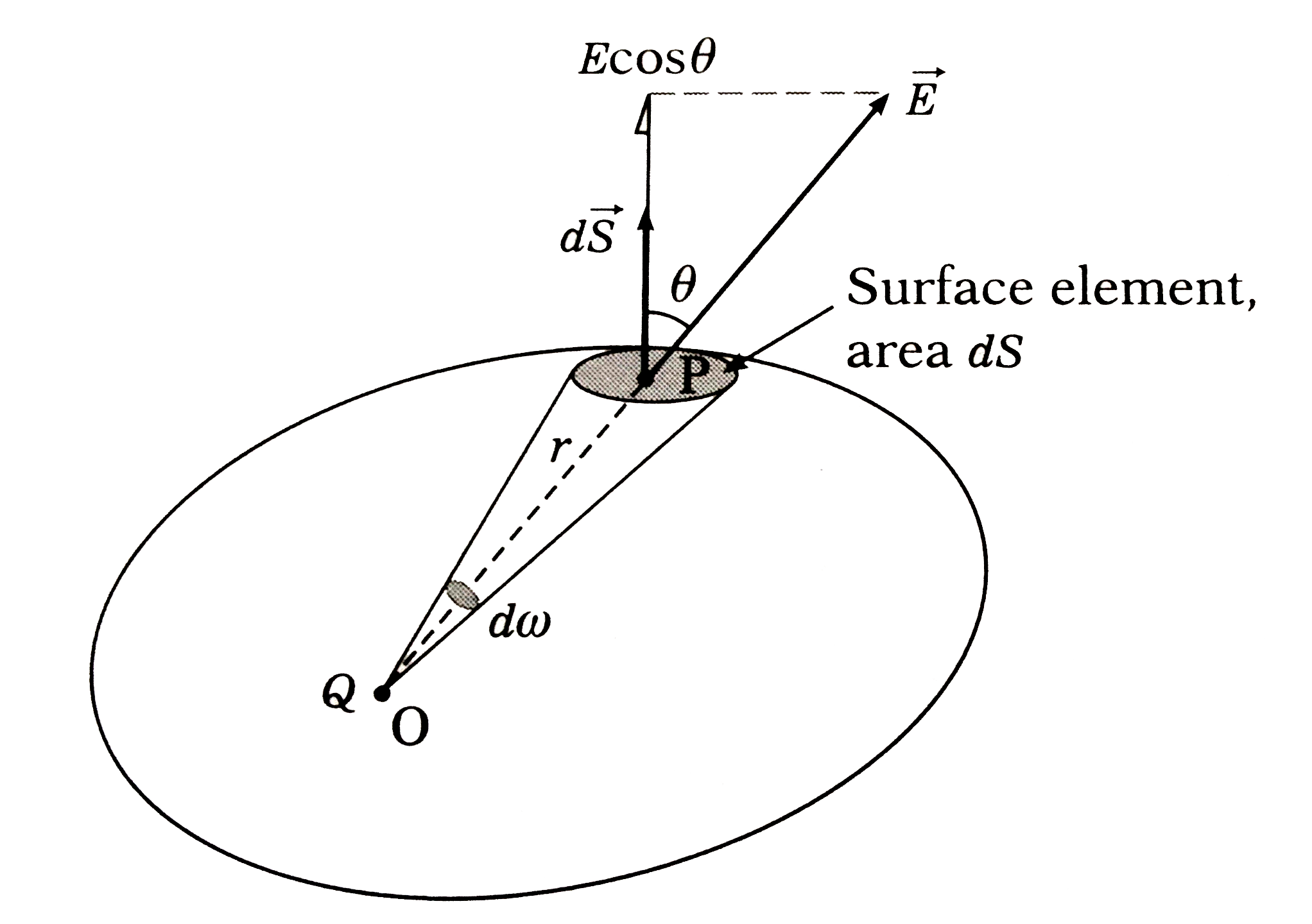State and prove Gauss's law in electrostatics.
Gass's theorem : The total normal electric induction (TNEI) over a closed surface is equal to the algebraic sum of the charges, I .e., the net charge, enclosed by the surface.

Proof : Consider a closed surface of arbitrary shape surrounding a positive point charge Q, as shown in the figure.
Consider a small element of the surface, of area dS around a point P at a distance r from the point O. The area dS is assumed to be so small that every point on it can be considered to be at the same distance r from O and the electric field over it can be considered to be uniform. The magnitude of the electric field at P is
E=Q4πεr2 ...(1)
where ε is the permittivity of the medium surrounding the point charge.
The outward normal d→S drawn to the area element makes an angle θ with the electric field. Hence, the total normal electric induction TNEI over area dS
=εEcosθdS=ε(Q4πεr2)cosθdS=Q4π⋅dScosθr2 ...(2)
dScosθr2 is the solid angle dε subtended by the area dS at O.
∴ TNEI over dS=Q4πdε ...(3)
∴ TNEI over the closed surface =∮θ4πdε=Q4π∮dε ...(4)
A closed surface subtends a solid angle of 4π steradians at any point inside it, i.e., ∮dε=4π steradians. ...(5)
∴ TNEI over the closed surface =θ4π×4π=Q ...(6)
Instead of a single free charge, if there are many free charges, we can write Eq. (6) for each point charge and then sum over all the chares.
∴ TNEI over the closed surface =ΣQ ...(7)
where ΣQ is the algebraic sum of all free charges, i.e., the net charge, enclosed by the surface. This proves Gauss's theorem.
Topper's Solved these Questions
- BOOK - NAVNEET PUBLICATION - MAHARASHTRA BOARDCHAPTER - DERIVATIONS-IIEXERCISE - Current Electricity6videos
DERIVATIONS-II
- BOOK - NAVNEET PUBLICATION - MAHARASHTRA BOARDCHAPTER - DERIVATIONS-IIEXERCISE - Magnetism1videos
DERIVATIONS-II
- BOOK - NAVNEET PUBLICATION - MAHARASHTRA BOARDCHAPTER - DERIVATIONS-IIEXERCISE - Interference and Diffraction4videos
DERIVATIONS-II
- BOOK - NAVNEET PUBLICATION - MAHARASHTRA BOARDCHAPTER - DERIVATIONS-IEXERCISE - Assignments9videos
DERIVATIONS-I
- BOOK - NAVNEET PUBLICATION - MAHARASHTRA BOARDCHAPTER - DISTINGUISH BETWEENEXERCISE - Assingment3videos
DISTINGUISH BETWEEN
Similar Questions
Knowledge Check
- Question 1 - Select One
What is the nature of Gaussian surface involved in Gauss's law of electrostatics?
AScalarBElectricalCMagneticDVector - Question 2 - Select One
The unity of the electriec and magnetic waves was found by Maxwell from
(i) Guss's law in electrostatics
(ii) Gauss's law in magnetism
(iii) Faraday's law of electromagnetic induction.
(iv) Ampere's law with displacement current.A(i) and (iii) onlyB(iii) and (iv) onlyCallDVelocity of light also
State and prove Hooke's law.
View SolutionState Gauss's law in electrostatics. Using this law derive an expression for the electric field due to a uniformly charged infinite plane sheet.
View SolutionState Gauss's law in electrostatics. Use this law to derive an expression for the electric field due to an infinitely long straight wire of linear charge density λcm−1
View SolutionState Gauss' law in electrostatic. Using it derive an expression for the electric field due to an infinitely long straight wire of linear charge density λ C/m.
View SolutionState Gauss's law on electrostatics and derive an expression for the electric field due to a long straight thin uniformly charged wire (linear charge density ) at a point lying at a distance r from the wire.
View SolutionState the limitation of Coulomb's law in electrostatics.
View Solution
